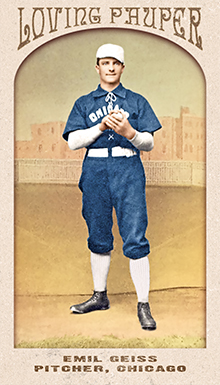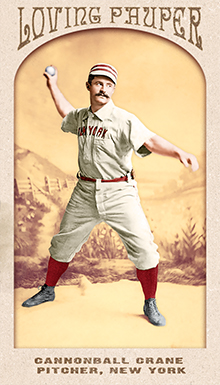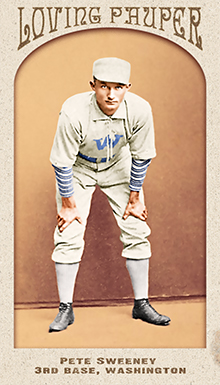
- Series: 1880s: Loving Paupers
- City: Chicago
- Team: White Stockings
- League: National League
Emil Geiss (1865-1911) emigrated from his birthplace, Villmar Germany, to Chicago. The youngster began his experience in professional baseball out in Colorado with the Pueblo Pastimes of the CO State League in 1885. The scanty records for minor league play in those days record Emil started two games, finished them both and went 1-1. There is no data for Geiss’ activities the following year, but one might suppose he did something somewhere to impress the Chicago White Stockings as the National League power thought fit to sign Emil for the ‘87 season. Whatever Cap Anson’s hopes were, they died aborning as Geiss languished with the team. He got shelled in his one start (11 runs, eight earned) and not only left the major leagues, he left his adopted land. Geiss signed the following two seasons with London Ontario Canada’s Tecumsehs of the International Association and stayed for the 1889 campaign when the Tecumsehs joined the International League. In those two years Geiss was 21-21 . But for his sole outing in Chicago, he would have completed his pro tenure with a symmetrical record of 22-22.
- There is no doubt Emil belonged in the pitcher’s box as his hitting gave no indication he could perform anywhere else. He never cracked the .200 mark and was one for 12 with the White Stockings. His three errors in his brief time in the majors suggest it wasn’t just his bat that would be a detriment to longevity at that level
- The reason Geiss had twelve at bats in Chicago is that Anson put him at first base and second base in two other appearances
- Emil’s older brother Bill also saw major league duty, playing two seasons. He debuted with Baltimore in the American Association in 1882 and then joined the Detroit Wolverines of the NL in ‘84
Auction History
Cartophilia
Old Judge Pose: 182-2

- Series: 1880s: Loving Paupers
- City: New York
- Team: Giants
- League: National League
Edward Nicholas Crane (1862-1896) began in major league ball with the notorious Boston Reds of the Union Association - a hard-drinking crew. It appears that big Ed avoided the bottle that would eventually kill him years later when he joined Al Spalding’s world exhibition tour. That he even made that trip was highly unlikely as Cannonball had labored in anonymity for years until the 1889 “World Series,” where Jim Mutrie played a hunch and decided his Giants could best the Bridegrooms with fastballs. Crane was tapped for five starts, won four and the Series. Cannonball could always throw hard and was famed for a 406’ long-toss, but such post-season heroics were virtually unheard of. The seeds of Ed’s doom had been planted on that tour however, nourished by the vices of Paris. All too soon he would spiral into alcoholism and an early death. While the coroner ruled Crane's death an accidental overdose, rumors persisted that he had taken his own life by drinking acid.
- Ed had one of the great seasons of any pitcher for the Toronto Maple Leafs in ‘87 with 33 wins and an eye-popping .428 BA (when walks counted as hits)
- Other firsts: 1st NY Giant to hurl no-hitter; 1st pitcher with four Ks in an inning
Auction History
Cartophilia
Old Judge Pose: 96-6

- Series: 1880s: Loving Paupers
- City: Washington, D.C.
- Team: Nationals
- League: National League
Peter Jay Sweeney (1863-1901) played infield and outfield on the west coast beginning at the tender age of 15 with two San Francisco clubs. He moved across the bay to Oakland in 1881, then came back to Baghdad by the Bay with the SF Haverlys in 1884-85. At age 24, Pete got his big chance, joining the Washington Nationals in '88. He returned to D.C. the following season and was moved to the St. Louis Browns later in '89. They demoted him briefly to the St. Paul Apostles, but brought Sweeney back in 1890 before trading him to the Philadelphia Athletics who sent him later the same season to the Louisville Colonels. His major league tenure ended in Louisville with Pete seeing action for four clubs in a mere three years. He was far from finished with baseball, however. Sweeney had a coast-to-coast season in 1891, playing back home for Oakland and finishing the year with the Rochester Hop Bitters in the Eastern Association. Thereafter, this wanderer would roam from California League teams to the east coast and even a season with the Nashville Tigers of the Southern League. Having begun in 1879, this lifer didn't hang 'em up until concluding the 1897 campaign with the Sunbury Pirates of the Central Pennsylvania League. There was a reason he spent most of his time in the minors: he couldn't hit big league pitching. Pete's average for his four MLB clubs was a paltry .209. Yet, he could thrive in the lower levels of the game. When he left the big leagues for Rochester, Sweeney led the Eastern Association in home runs.
- Not a lot of native Californians got to play in the majors in the nineteenth century, but while playing for the San Francisco Knickerbockers in 1879, Sweeney did play alongside one early luminary: The Only Nolan. A pitcher, perhaps from Canada, Edward Nolan sported one of the great appellations in the game
- Only one teammate from the Haverlys made it to the majors: John Smith. He had a cup of coffee in 1882 with the Troy Trojans and Worcester Ruby Legs, then of the National League
Auction History
Cartophilia
Old Judge Pose: 451-1

- Series: 1880s: Loving Paupers
- City: Pittsburgh
- Team: Alleghenys
- League: National League
Alexander J. McKinnon (1856-1887) was a remarkably talented player who was cut down in his prime by a scourge of the 19th century, typhoid fever. The tragedy was even more poignant inasmuch as McKinnon had endured numerous illnesses in his youth that had prevented him from really beginning what was on its way to a very fine career. As if sickness wasn't enough of a hardship for young Alex, he was also hindered in the beginning of his pro tenure by league politics and evolving contractual arrangements. He had begun playing for the Syracuse Stars in 1877, staying in NY with Albany/Rochester for the '79 season before heading west to the San Francisco Athletics of the California League in 1880. This move was precipitated by a squabble that involved William Hulbert of the new National League. Alex was assigned to the Troy Trojans for the 1879 season, but wanted to play for Rochester of the International League. Despite some back-room dealings that should have cleared up the controversy, Hulbert expelled McKinnon. A combination of illness that plagued him lifelong and this contract dispute seems to have led him to make the move west and then drop out of baseball altogether for a few years. Clearly McKinnon's talent was recognized and Hulbert relented, allowing Alex to be signed for the '83 season by the Philadelphia Quakers - but the young man was too sick to play. Finally, in 1884, the New York Gothams (not yet the Giants) signed Alex and he began a belated major league tenure that showed tremendous promise. Indeed, in the four short years he played for three NL teams - NY, St. Louis and Pittsburgh - Alex steadily improved his batting average. He hit .272 for the Gothams, jumped to .294 and .301 with the Maroons and was hitting a stunning .365 in 1887 when he was stricken with an ailment he couldn't lick, typhoid. After his mid-season death, the Alleghenys honored Alex by donning black crepe for the duration of that campaign.
- McKinnon was not just a good and ever-improving batter, he became a star in the field. He led the NL in fielding percentage in 1885 with a .978 record. This was all the more striking given his difficulty at first base for the Gothams the prior year when he made 53 errors. Clearly this star-in-training was a quick study
Auction History
Cartophilia
Old Judge Pose: 315-1

- Series: 1880s: Loving Paupers
- City: New York
- Team: Giants
- League: National League
Elmer Ellsworth Cleveland (1862-1913) was a third baseman and shortstop who was a good enough hitter to carve out a very respectable pro career, principally in the minors. He began with Johnstown of the Western Interstate League in 1883 and, as so many of his talent and age, got a chance at the “big leagues” the following season with the Cincinnati Outlaw Reds, the aptly-named club in the upstart Union Association. Elmer actually had a great season for Cincy playing against other mostly minor league talent. He hit .322 in 29 games. His limitations as a hitter caught up to him in his future appearances with major league teams. He next came up with the New York Giants in 1888, getting into nine games before being shipped to Pittsburgh's Alleghenys where he got into 30 games. His combined average tumbled to .235. Cleveland got one more shot, with the Columbus Solons of the American Association in 1891 where his miserable .171 average signaled the end of any dreams of big league glory. Nevertheless, he stayed in minor league baseball through his twenties, finally calling it quits after playing the 1892 season back in Johnstown with the Pirates, now in the Pennsylvania State League and finishing up the year with Danville in the same circuit. His opponents that year included the Wilkes-Barre Coal Barons, the Reading Actives and the Lebanon Pretzel Eaters.
- Cleveland must have cut an imposing figure in that era, standing 5'11” and tipping the scales at 190 lbs. However, the sturdy third baseman learned the unfortunate consequences of not hitting one's weight
Auction History
Cartophilia
Old Judge Pose: 80-2




